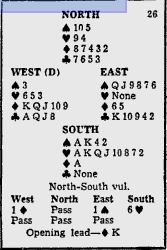Sarasota Herald-Tribune – 24 Mar 1952
The safety play is usually a way of losing a trick that nobody else would dream of giving away. The opponents usually look at you pityingly and explain how any player in his right mind would have made one trick more than you did.
It’s much more satisfactory when the safety play turns out to be necessary. Then the opponents glare at you and don’t bother to give you lessons in the play of the cards. Today’s hand, played recently by Generous George had the opponents muttering unkind words for several minutes.
West opened the king of diamonds and George won with the ace. While you think of George’s method of playing the hand take a look at his way of bidding it also. Some players would have waxed scientific with the South hand, beginning with some such cue-bid as two diamonds or two spades, this would not improve South’s final contract, but it would give the opponents a chance to find a beautiful sacrifice at seven clubs (which is down only two ). George preferred to make all his bids in one lump, thus making it difficult for the enemy to get together on a paying sacrifice.
After winning the first trick with the ace of diamonds, Generous George cashed the ace of spades and led a low spade. As he led the low spade. George cleared his throat to make his I customary little speech, but West ‘glared at him so fiercely that George decided to keep quiet. There was nothing the defenders could do to defeat the contract. Nothing could stop George from ruffing his other low spade with dummy’s nine of trumps, after which he could return to his own hand to draw the rest of the trumps and cash the king of spades.
George would have lost the contract, of course, if he had tried to clear both of the top spades. West would ruff the king of spades and return a trump. South would then have two losing spades and only one trump in dummy so he would have to lose a second trick.
